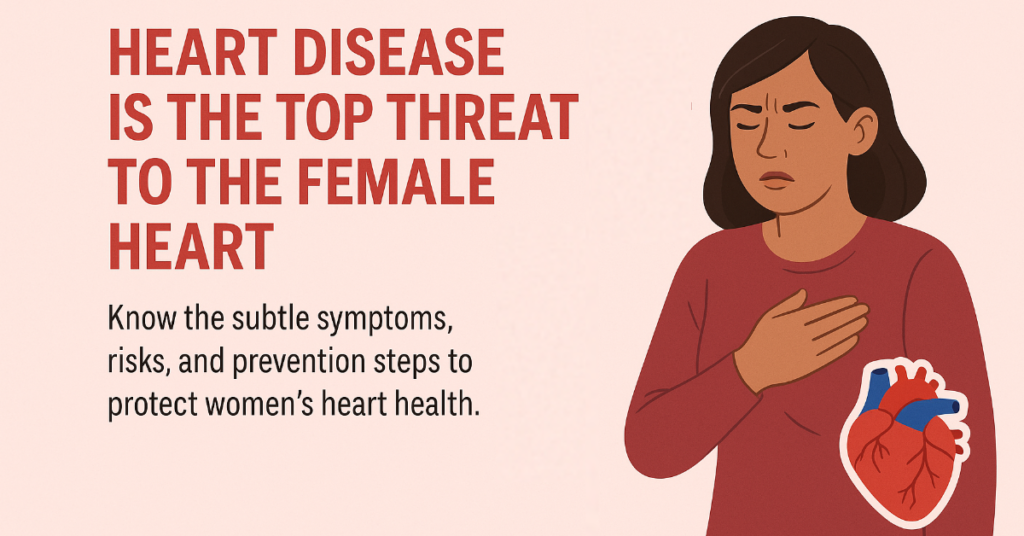Heart disease is often viewed as a men’s health issue, but the truth tells a different story: heart disease is the leading cause of death among women worldwide. Despite this, female heart attacks often go unrecognized or misdiagnosed because their symptoms differ significantly from the classic signs most people associate with heart attacks-those based largely on men’s experiences. This unspoken story deserves attention, as awareness can save lives.
Why the Difference? Understanding the Female Heart
Before diving into symptoms, it’s important to understand why women experience heart attacks differently than men. While both genders share the same basic heart anatomy, hormonal and physiological differences influence how heart disease develops and manifests:
Hormonal Influence: Estrogen, present in higher levels before menopause, helps maintain flexible blood vessels and healthy cholesterol levels, offering women some protection. Post-menopause,around 50 to 55 years of age, estrogen levels decline, increasing risk.
Plaque Build-Up Patterns: Men typically develop blockages in larger arteries of heart (coronary arteries), leading to the dramatic chest pain we see in movies and real life too. Women, on the other hand, often develop blockages in smaller arteries (microvascular coronary artery disease). This makes symptoms of heart attacks less obvious.
These differences set the stage for atypical symptoms that can easily be mistaken for something else.
Classic vs. Atypical Symptoms
Most people think of a heart attack as a sudden, crushing pain in the chest going down the left arm. While men often report this classic symptom, women frequently experience a broader and subtler range of symptoms.
What Men Typically Experience
Intense chest pressure or squeezing
Pain radiating to the left arm
Sweating / Sudden collapse
What Women Often Experience
Mild chest discomfort (if any) / Shortness of breath
Extreme fatigue / Pain in the neck, jaw, shoulders, or upper back
Nausea or vomiting / Indigestion-like discomfort
Dizziness or lightheadedness
Women may experience multiple symptoms simultaneously, or they may appear gradually over hours or even days—making them easier to dismiss.
The Unspoken Signs of female heart attack: Subtle but Serious
Let’s break down the most common heart attack signs in female heart:
1. Chest Discomfort—Not Always Dramatic
Women can experience chest pain, but it often feels different from the crushing pressure men describe. It may feel like:
Tightness / Squeezing / Fullness
Sometimes the sensation is mild and intermittent, leading women to attribute it to stress or indigestion.
2. Unexplained Fatigue
One of the earliest and most overlooked signs is unusual fatigue—feeling drained even after adequate rest. Women often describe exhaustion so severe they can barely perform routine activities like climbing stairs.
3. Shortness of Breath
Women frequently experience breathing difficulties during a heart attack, even without chest pain. If you suddenly find yourself gasping for air while sitting or doing minimal activity, take it seriously.
4. Pain in Unusual Areas
Unlike men, who often feel pain in the chest and arm, women may feel discomfort in:
Neck or jaw / Upper back or shoulders /Arms (one or both)
This pain can come and go or feel like a dull ache.
5. Gastrointestinal Symptoms
Nausea, vomiting, or a burning sensation in the upper abdomen are surprisingly common during female heart attack. Many dismiss these as acid reflux, food poisoning, or a stomach infection, delaying treatment.
6. Cold Sweats and Lightheadedness
Breaking out in a sudden cold sweat or feeling dizzy and faint can indicate that the heart isn’t pumping blood effectively.
Also Read: Menopause and Heart Health: Why Women’s Risk Rises and How to Stay Healthy
Why Women Miss the Warning Signs
Several cultural and medical factors contribute to why these symptoms go unnoticed:
Multitasking and Caregiving Roles: Women often juggle work, family, and household responsibilities, dismissing symptoms as stress or exhaustion.
Medical Bias: Historically, most heart disease research focused on men. As a result, doctors may underestimate women’s risk, especially younger women.
Misinterpretation of Symptoms: Fatigue or indigestion is rarely linked to heart issues in the public mindset.
Unfortunately, these factors lead women to delay seeking care—sometimes for days. Research shows women wait an average of 37 minutes longer than men to call emergency services during a heart attack. This delay can be fatal.
The Consequences of Delay
Every minute counts when a heart attack occurs. The longer the heart muscle is deprived of oxygen, the greater the damage. Delayed treatment can result in:
Permanent heart muscle damage / Heart failure
Irregular heartbeat / Sudden Death
Post menopausal women face an additional risk: they are more likely than men their age to die within a year of a first female heart attack. This makes early recognition crucial.
Risk Factors Women Should Know
While the classic risk factors apply to both genders ie. high blood pressure, high cholesterol, smoking, diabetes; women also face unique risks:
Hormonal Changes: Menopause significantly increases risk.
Pregnancy Complications: Conditions like preeclampsia or gestational diabetes raise long-term risk.
Autoimmune Disorders: Diseases such rheumatoid arthritis affect women more and increase heart attack risk.
Depression and Stress: These mental health factors have a stronger impact on women’s heart health compared to men.
What Women Can Do to Protect Themselves
1. Learn the Symptoms
Knowledge is power. Familiarize yourself with the nontraditional symptoms,mentioned above and take them seriously.
2. Monitor Your Risk Factors
Regularly check blood pressure, cholesterol, and blood sugar. Maintain a healthy weight and avoid smoking.
3. Act Fast
If you suspect a heart attack:
Call emergency services or inform family members immediately.
Take a aspirin tablet, if advised by a doctor or emergency operator.
4. Advocate for Yourself
If you feel something is wrong, speak up. Insist on proper testing, such as an ECG, blood tests, and imaging like echocardiogram. Use direct language like, “I think this could be my heart.”
5. Prioritize Prevention
Adopt heart-healthy habits:
Eat a balanced diet rich in fruits, vegetables, and whole grains.
Exercise (arerobic) regularly (150 minutes of moderate activity per week).
Manage stress with mindfulness, yoga, or deep breathing.
Get regular health check-ups.
Changing the Narrative
For too long, the story of heart attacks has centered on men. But female heart experiences need equal attention. By recognizing that symptoms in women are often quieter but equally deadly, we can rewrite this narrative. Awareness campaigns, better education for healthcare providers, and open conversations among women are essential steps toward reducing heart-related deaths.
Heart disease doesn’t discriminate; but awareness and action can make all the difference. The next time you feel unusually fatigued, short of breath, or experience persistent discomfort; even if it seems minor – listen to your body. Heart attacks in women rarely look like the dramatic scenes portrayed in movies. Instead, they often whisper their warnings through subtle, easily overlooked symptoms. By understanding these differences and acting quickly, women can rewrite the narrative and protect their most vital organ – The Heart.



